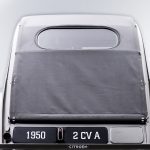
(English below)
Auf dem Oldtimer-Salon Rétromobile 2018, der vom 7. bis 11. Februar in Paris stattfindet, ehrt Citroën zwei Ikonen: Der Citroën 2CV aus dem Jahr 1948 feiert seinen 70. Geburtstag und der Citroën Méhari aus dem Jahr 1968 seinen 50. Zu besonderen Anlässen wie diesen stellt die Marke den Urvater des 2CV aus, den Prototypen TPV („Toute Petite Voiture“ = ganz kleines Auto) aus dem Jahr 1939. Darüber hinaus bereitet Citroën ein weiteren großen Geburtstag vor: In 2019 feiert die Marke ihr hundertjähriges Jubiläum.
Der Citroën 2CV wird 70 − der volksnahe Mythos
Seine Weltpremiere feierte der Citroën 2CV auf dem Pariser Automobilsalon 1948 im Beisein des damaligen französischen Staatspräsidenten Vincent Auriol. Auf Anhieb raubte er dem Publikum den Atem. Einige machten sich über seine außergewöhnliche Silhouette lustig − andere bemerkten bereits, dass der Citroën 2CV über sämtliche Eigenschaften verfügte, die zahlreichen damaligen Modellen fehlten, darunter Schlichtheit, Leichtigkeit, Agilität, Komfort und Vielfältigkeit.
Nach der Vorstellung des Citroën 2CV gab der hohe Bestelleingang der Marke und ihren visionären Entwicklern Recht. Entwicklungsleiter André Lefebvre stattete den Citroën 2CV mit für damalige Zeiten zahlreichen pfiffigen Technologien aus, wie einem Frontantrieb, einer weichen Federung mit langem Federweg und einem luftgekühlten Zweizylinder-Motor.
Der volksnahe Citroën 2CV wurde zum festen Bestandteil der Gesellschaft: Bauern, Priester, Familienväter und Studenten saßen am Steuer. Das beliebte Modell blickt auf eine einzigartig lange Karriere von 42 Jahren zurück. Bis 1990 wurden mehr als 5,1 Millionen Citroën 2CV (inklusive Kastenwagen) verkauft. Heute zählt der als „Ente“ bekannte Citroën 2CV zu den Ikonen der Automobilgeschichte und zum Mittelpunkt einer großen Sammlergemeinde weltweit.
TPV, Urvater des Citroën 2CV (1939)
Das Projekt TPV, der Urvater des Citroën 2CV, wurde 1936 vorgestellt. Ziel des Projekts war, ein „ganz kleines Auto“, ein „Toute Petite Voiture (TPV)“ für jedermann, zu entwickeln. Das Fahrzeug sollte die Anforderungen im ländlichen Raum erfüllen und für die arbeitende Klasse erschwinglich sein − in einer Zeit, in der das Automobil ein Luxusobjekt war. Schlichtheit, Wirtschaftlichkeit und Vielseitigkeit lauteten die Vorgaben: „Vier Personen und fünfzig Kilogramm Kartoffeln oder ein Fässchen mit einer Spitzengeschwindigkeit von 60 km/h befördern zu können“. Das Ergebnis hatte 370 Kilogramm Leergewicht und kostete in der Produktion ein Drittel eines Citroën 11CV. Der Prototyp TPV hatte lediglich einen Scheinwerfer, denn die damalige Gesetzgebung schrieb keine zwei Scheinwerfer vor.
1939 standen rund 250 Vorserienmodelle zum Pariser Automobilsalon bereit. Aufgrund des Kriegsausbruchs fand dieser allerdings nicht statt. Die Fahrzeuge wurden absichtlich zerstört oder versteckt. Heute sind nur noch vier Exemplare übrig, darunter das restaurierte Modell, das auf der Rétromobile ausgestellt wird. Drei weitere wurden 1994 auf dem Speicher eines Bauernhofs in der Nähe des Citroën Entwicklungszentrums im französischen la Ferté-Vidame entdeckt.
Der Citroën Méhari wird 50 – Konventionen in Frage stellen
Im Mai 1968, als eine ganze Generation auf den Pariser Straßen mehr Freiheiten forderte, überraschte Citroën mit der Präsentation des Méhari, einem Fahrzeug mit hohem Freizeitwert, das seiner Zeit weit voraus war. Der außergewöhnliche, offene Citroën Méhari basierte auf der Plattform der Citroën Dyane 6. Mit seinem einzigartig frischen, freien, unprätentiösen Auftritt stellte er herkömmliche Konventionen in Frage.
Der vielseitige, praktische und sparsame Citroën Méhari war der ideale Begleiter für Ausflüge ans Meer. Seine pfiffige, leichte Karosserie aus ABS-Kunststoff (525 Kilogramm) war nicht rostanfällig. Zudem ließ sie sich außen wie innen mit einem simplen Wasserstrahl reinigen. Der unorthodoxe, gesellige, optimistische Citroën Méhari überzeugte durch seinen vielseitigen Charakter und seinen farbenfrohen Auftritt. Er war auf Anhieb von Erfolg gekrönt.
Der Citroën Méhari steht für Freiheit und für eine schlichte, sorgenfreie Lebensart. Bis heute ist er ein Phänomen der Automobilgeschichte. Der Citroën Méhari blickt auf eine große Karriere in bekannten Kinofilmen (beispielsweise in „Der Gendarm von Saint-Tropez“ mit dem berühmten französischen Schauspieler Louis de Funès) und in bedeutenden Wettbewerben in aller Welt (darunter Raid Lüttich-Dakar-Lüttich 1969, Raid Paris-Kaboul-Paris 1970) zurück.
In nahezu 20 „Lebensjahren“ (bis 1987) wurden rund 145.000 Exemplare des Citroën Méhari produziert.
Zwei einzigartige Werke feiern den nostalgischen Charakter des Citroen 2CV und des Méhari
Da der Citroën 2CV und der Méhari bei einer ganzen Generation Kindheitserinnerungen wecken, werden die Geburtstage dieser Automobil-Ikonen auch künstlerisch begangen. Zwei eindrucksvolle Werke von Stéphane Gillot bringen jedes einzelne Teil der legendären Modelle zur Geltung.
Der Künstler und Fernsehproduzent war schon als Kind vom Modellbau fasziniert. Heute lässt er das Imaginäre wieder aufleben. Mithilfe von Kunstschmieden schneidet er alte, nostalgische sowie industrielle Gegenstände aus und verarbeitet sie zu Gittern wie in Modellbaukästen. Die flach angeordneten Elemente vermitteln das Gefühl, Teil eines brandneuen Modellbaukastens zu sein, der nur darauf wartet, zu neuem Leben zu erwachen. Im Gegensatz zum herkömmlichen, miniaturisierten Modellbau schafft Stéphane Gillot Werke im Maßstab 1:1 aus geschichtsträchtigen Teilen. Im Oktober 2017 stellte der Künstler zwölf seiner Werke im Pariser „Théâtre de la Madeleine“ aus, vom VéloSolex bis zum Tischfußball Bonzini.
Auf der Oldtimer-Messe Rétromobile stellt Citroën Stéphane Gillots Vision des legendären Méhari sowie sein neuestes Werk mit dem einzigartigen Citroën 2CV aus. Bereits auf den ersten Blick wecken diese beeindruckenden Kreationen freudige Kindheitserinnerungen (www.1on1.fr und Facebook).
Mit weiteren Modellen in die Vergangenheit reisen
Gestern wie heute steht Citroën für Kreativität und automobile Freiheit. Auf der Rétromobile wird das jüngste Modell der Marke, der neue Compact SUV Citroën C3 Aircross, an der Seite der beiden Werke von Stéphane Gillot präsentiert. Dank der Citroën Clubs werden die Besucher weitere legendäre Modelle der Marke bewundern können. Die Reise führt in die Vergangenheit, von den dreißiger bis zu den siebziger Jahren.
Die ausgestellten Modelle auf einen Blick:
Citroën C4F Large 1931
Citroën Traction Avant 11AL Cabriolet 1935
Citroën Traction Avant 11BL Coupé 1938
Citroën 2CV Typ A (TPV) 1939
Citroën 2CV Spécial 1976
Citroën Méhari 1969
Citroën CX 2000 Super 1979
Citroën C3 Aircross 2018
Das Logo des hundertjährigen Jubiläums der Marke wird enthüllt
Auf der Rétromobile 2018 wirft die Marke Citroën einen Blick voraus auf Ihr hundertjähriges Jubiläum. Das Jahr 2019 wird von zahlreichen feierlichen Ereignissen geprägt. Auf der Oldtimer-Messe wird nun das Logo des Jubiläums enthüllt. Es trägt den Namen der Marke „Origins“, die im Juni 2016 zur Eröffnung des virtuellen Museum Citroën Origins gegründet wurde. Origins steht für alle Ereignisse und Produkte, die mit der Geschichte der Marke verbunden sind. Als Augenzwinkern an das ursprüngliche Logo der Marke aus dem Jahr 1919 wird der Doppelwinkel in einem Oval eingerahmt. Der Doppelwinkel geht auf das erste Unternehmen von André Citroën zurück, das sich auf die Fertigung von Winkelzahnrädern spezialisierte.
Wie jedes Jahr haben Besucher die Möglichkeit, sich am Citroën Stand mit Vertretern der Citroën Clubs auszutauschen. In einem Merchandising-Shop werden zudem Produkte rund um Citroën angeboten.
Bis zur Rétromobile gibt das Online-Museum Citroën Origins dem Besucher einen Einblick in die legendären Modelle der Marke mit dem Doppelwinkel: citroenorigins.de.
Kontakt:
CITROËN DEUTSCHLAND GmbH
Presse und Öffentlichkeitsarbeit
Susanne Beyreuther
Telefon: 02203/2972-1412
E-Mail: susanne.beyreuther@citroen.com
- 2cv a
- 2cv a
- 2cv a
- 2cv a
- 2cv a
- 2cv a
- 2cv a
- 2cv a
- 2cv azu
- mehari
- mehari
- mehari
- mehari
- mehari
- mehari
- mehari
- mehari
- mehari
—–
RETROMOBILE 2018: CITROËN IS CELEBRATING THE 2CV’S 70TH ANNIVERSARY, THE MÉHARI’S 50TH ANNIVERSARY, AND IS GETTING READY FOR ITS OWN 100TH BIRTHDAY…
During the 2018 Rétromobile Classic Car Show, which will take place in Paris February 7 to 11, Citroën will be celebrating two iconic models: The 2CV, which debuted in 1948 and is turning 70, and the Méhari, launched in 1968 and turning 50 this year. The Brand is making the most of this rare opportunity by showing off the 2CV’s ancestor, a prototype that came out of 1939’s TPV (Toute Petite Voiture, or Very Small Car) project. These two anniversaries are also being marked with some original works of art: two large flat ‘kits’ of spare parts, just like those children use to make models. The only difference is the scale, since these are real 2CV and Méhari parts! The Brand is also beginning its preparations for another important anniversary: its own 100th birthday, which it will celebrate in 2019!
Citroën is happy to invite visitors to come see their display in Pavilion 1 at the 2018 Rétromobile Classic Car Show (held at Paris Expo Porte de Versailles), which will take place between Wednesday 7 February and Sunday 11 February (with a press evening on Tuesday 6 February at 7 p.m.). Come take a trip through time and return to memories of childhood…
THE 2CV AT 70, A PART OF THE POPULAR IMAGINATION
The 1948 Paris Motor Show. The Citroën 2CV was unveiled before French President Vincent Auriol, stunning the crowd that had gathered to see it. While some laughed at its unique silhouette, others saw in it the qualities that had been missing from so many other models: simplicity, lightness, agility, comfort, versatility, etc.
The large volume of orders that came flooding in, even in those first days, proved that the Brand and its visionary designers were on to something. André Lefebvre, head of the Citroën design office, provided the 2CV with a whole host of technologies that were novel at the time: front-wheel drive, a soft long-travel suspension, an air-cooled two cylinder engine, etc.
With its great popularity, the Citroën 2CV became a real social phenomenon: a car for farmers and vicars, for fathers and students. It had an exceptional 42-year run, with more than 5.1 million vehicles sold (including compact vans) by 1990. Today, the 2CV, affectionately called the ‘Deuche’ in French, remains an icon of automotive history, piquing the interest of collectors from around the world.
TPV, ancestor of the 2CV (1939)
The TPV (Toute Petite Voiture or Very Small Car) project, forerunner of the 2CV, was launched in 1936. Its goal was to make cars into a common commodity, something that would be useful in the agricultural sector and accessible to the working classes at a time when cars were still seen as luxury items. To achieve this, simplicity, frugality, and ingenuity had to come together in the pursuit of a single goal: “transporting four people and fifty kilos of potatoes or a small barrel at the top speed of 60 km/h”. Result: the vehicle weighed 370 kg empty, and cost one third as much as the 11 CV. It even had only one headlamp, because the laws at the time didn’t require 2!
In 1939, about 250 pre-production models were ready for the Paris Motor Show…which was unfortunately cancelled when war broke out. These vehicles were voluntarily destroyed or hidden. Only four have made it through to today, including the restored model on display at the Rétromobile Classic Car Show. The other three were found in 1994 in the inaccessible attic of a farm near Citroën’s Testing Centre in Ferté-Vidame…
THE MÉHARI AT 50, STILL A NON-CONFORMIST
May 1968. Just as an entire generation were taking to the streets of Paris in search of greater freedom, Citroën unveiled a leisure vehicle ahead of its time: the Méhari. This unusual cabriolet, built on a Dyane 6 base, was almost like an unidentified driving object on the roads at that time. And with good reason: its surprising appearance – fresh, uninhibited, and unpretentious – overturned traditional thinking about cabriolets.
Versatile, practical, and economical, the Citroën Méhari was the ideal choice for seaside adventures thanks to its ingenious ABS plastic body, which made it light (525 kg), immune to corrosion, and able to be washed top to bottom with just a hose. Unusual, but also fun and optimistic with its considerable modularity and pop colouring, this little Citroën was an immediate popular success.
As a symbol of freedom and a simple, carefree life, the Citroën Méhari quickly became a social phenomenon. It also had a considerable film career (appearing notably in the popular Gendarme series starring Louis de Funès) and took to the road all around the world (Liège-Dakar-Liège rally in 1969, Paris-Kabul-Paris rally in 1970, etc.).
The Méhari remained in production for almost 20 years, up through 1987, selling 145,000 vehicles.
TWO ORIGINAL WORKS INSPIRED BY NOSTALGIA FOR THE 2CV AND MÉHARI!
Because the 2CV and Méhari are often associated with an entire generation’s childhood memories, the anniversaries of these two automotive icons are also being celebrated artistically! Each model has been magnified, piece by piece, in two monumental works of art by Stéphane Gillot. Mr Gillot is an artist and television director who had a passion for model building as a child. Today, he engages with the popular imagination surrounding nostalgic industrial objects from the past by cutting them up and making them into kits with help from skilled metalworkers. When these objects are deconstructed and made into a flat kit, they look like they’re a new scale model, fresh out of the box, full of possibility and new life. However, whereas traditional scale models are smaller than the real thing and made out of new pieces, Stéphane Gillot’s works are on a 1:1 scale and they use real parts that are full of history. Mr Gillot exhibited work in this vein at the Madeleine Theatre in Paris last October, displaying 12 different products that had been broken up and arranged into flat kits, from a VéloSoleX moped to a Bonzini table football table.
At the Rétromobile Classic Car Show, Citroën is proud to display the artist’s vision of the iconic Méhari, as well as his latest creation using the 2CV. This exploded and magnified view of these two models connects viewers with their childhood, acting just like Proust’s madeleine!
Exclusive photos of the creation of the artwork using the 2CV can be downloaded from our press site, Other works by the artist can be found at www.1on1.fr and on his Facebook.
TRAVEL THROUGH TIME WITH PLENTY OF OTHER MODELS!
Alongside the two models celebrating their anniversaries, the Brand is happy to show off its continuing creativity and vision of automotive freedom with its newest model: the Citroën C3 Aircross compact SUV. Other iconic Brand models will also be on display, thanks to competitions held by Citroën collectors clubs. Visitors are truly able to travel through time, from the 30s to the 70s!
All of the models on display at a glance:
1931 Citroën C4F Large
1935 Citroën Traction Avant 11AL Cabriolet
1938 Citroën Traction Avant 11BL Cabriolet
1939 Citroën 2CV Type A (TPV)
1976 Citroën 2CV Special Edition
1969 Citroën Méhari
1979 Citroën CX 2000 Super
2018 Citroën C3 Aircross
UNVEILING OF THE LOGO FOR THE BRAND’S 100TH ANNIVERSARY
Citroën is also using the 2018 Rétromobile Classic Car Show to involve Citroën collectors’ clubs in the preparations for the Brand’s 100th birthday, which will be celebrated throughout 2019. The Brand is using this occasion to unveil the logo for this celebration. This logo plays off of the ‘Origins’ logo designed in 2016 as part of the creation of the Citroën Origins virtual museum that has since been used for all activities related to the Brand’s history, and especially for merchandising.
This logo is a playful wink at history, using chevrons enclosed in an oval just as the Brand did in its early days, starting in 1919. This pattern came from André Citroën’s first company, which manufactured herringbone gears that have a similar chevron pattern…
Just as in previous years, visitors will have the opportunity to talk with representatives from the collectors’ clubs, who will be on site. There will also be a shop for purchasing Brand merchandise.
While you’re waiting for the Rétromobile Classic Car Show, the Brand’s most iconic models from throughout its history can be found on the Citroën Origins website: www.citroenorigins.com (this virtual museum, with a collection of 62 vehicles, is available in 33 countries).
PRESS CONTACTS
Paul MAHOUIN – +33 (0)7 61 52 63 16 [Appeler : +33 (0)7 61 52 63 16] – paul.mahouin@citroen.com
Nathalie ROUSSEL – +33 (0)6 87 77 41 82 [Appeler : +33 (0)6 87 77 41 82] – nathalie.roussel@citroen.com




























